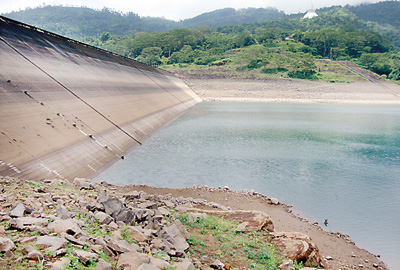News
Dry zone gets drier and drier, no drinking water
The scarcity of drinking water has added to the burdens of the villagers of the dry zone as the drought continued for the fourth successive month, officials said.
Drinking water is being distributed in bowsers to the hardest hit areas. “The reservoirs in the Puttalam District are drying up. Some villagers don’t have access to any source of drinking water. We have started distributing water to areas such as Nawagaththeegama, Mahakumbukkadawala and Mundalama,” Puttalam District Secretary Kingsley Fernando said adding that around 21,000 families are hit by the lack of drinking water.

The lack of water in the Kotmale reservoir affects cultivation in the Polonnaruwa District. Pic by Suranga Rajanayake
Hambantota District Secretary C. de Silva said they have been providing drinking water to affected villages since the beginning of February and that the demand was growing. Mr. Silva said cultivations in the district were also affected due to the lack of water but the priority now was providing drinking water to the people.
Vavuniya District Secretary Bandula Harischandra said that the Disaster Management Ministry had been notified of the shortage of drinking water in the district, following which the ministry had allocated Rs. one million for the distribution of water.
Meanwhile Anuradhapura District Secretary Neel de Alwis said discussions were held with the Water Board, Irrigation Zonal Director and Disaster Management officials about the situation regarding the lack of water. “We believe that the water in the tanks will last for about a month. Although the levels are below average in the tanks here, we are hopeful that the rains will soon come. Irrigation Department Director General Badra Kamaladasa commenting on the situation said, “As the rainfall is below average dependence on the reservoirs will be problematic not just for cultivation but also domestic work. People in the dry zone depend on the water they get from these water sources to carry out even their day-to-day activities.”
She said that the ground water levels, which fill the wells, are recharged by the water released by the reservoirs. “On the other hand for those who depend on inland fishing the water in the reservoirs have to remain at a certain level because if it gets dried up it would cause an environmental hazard.” About a year ago the water level in the Minneriya tank reduced which resulted in the water getting heated. The fish in the tank died as a result affecting the income of those who depend on inland fisheries, Ms. Kamaladasa said, adding that this could happen this year too. She said however the Irrigation Department was taking steps to avert such a situation by limiting the water released from the reservoirs.
“We also have to save water for the upcoming pilgrims’ season to Anuradhapura. Over 500,000 people enter the city in June to visit temples and other places of worship. We have to plan to meet the additional demand for water during this period,” she said.Meanwhile according to Irrigation Department sources farmers who depend on the Mee Oya river basin in the North Western Province for agricultural work were badly affected as it was drying up. The Inginimitiya reservoir a major water source for the Puttalam district had only about 13 per cent water stored in it.
The eight main reservoirs in the Ampara district got only 40 per cent of water stored in them, while the Senanayake Samudraya, the largest reservoir in the district reported only 38 per cent this year. “Although the 11 reservoirs in the Anuradhapura district indicate a level of 40 per cent and appears fine, it is not so. We should note that the evaporation rate during this time of the year is very high. In addition to that infiltration into the soil also takes place which means that we will lose more and more water,” Ms. Kamaladasa explained.Irrigation Department Water Management Director T. J. Meegastenna said that hydro power generation would also be hit by the prevailing drought.
“We will not receive enough water from the Kotmale and Victoria tanks. The government will have to use more thermal power which is expensive,” she explained.
Ms. Kamaladasa said although drought conditions prevailed in 2012 too its negative impact was less than anticipated. However this year she said most sectors would be affected. “The Meteorological Department predicts that in April we will be able to get rainfall but this won’t be enough. Past records show that during April the rainfall was about 100-200 mm. But May, June and July are dry months. This will cause at least five mm of water being evaporated each day,” she said.
Tea industry withers
The Tea Board fears that the drought conditions would affect the production of Tea, one of the country’s key exports.“Tea production in areas such as Ratnapura, Galle, Matara and Mid Country have dropped,” Tea Board Deputy Commissioner Bandula Jayamanne said. He said last year the sector recorded 340 million kilograms of tea production and they were hoping to increase it to 348 million this year, but the unexpected drought would make this target unattainable.
“Rainfall has been reported in some of the areas in the past few days and we hope we can recover soon. But we won’t be able to reach the expected level,” Mr. Jayamanne said.


